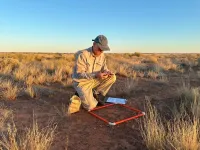(Press-News.org) Researchers have used dung records to create high-resolution maps of herbivore distribution around the world. Their new study, recently published in Nature Food, reveals a strong positive relationship between dung presence and grazing pressure, meaning the amount of dung found in a particular location could help us understand approximately how many herbivores live there.
Many people consider dung simply as the manure left behind by horses and cows at country shows, or something to be avoided when you visit the cousins’ farm. But dung is actually an important resource for millions of people worldwide.
Dung also acts a biological footprint – it can tell us a lot about our environment, such as what animals are grazing where, and what this might mean for environmental health.
Now, scientists from Australia, Spain, China and Saudi Arabia, led by Professor David Eldridge from UNSW Sydney, have produced the first global assessment of dung produced by livestock and native grazing animals in drylands – arid and semi-arid environments that occupy about 40% of the world’s land area.
The research revealed hotspots of dung production, but also highlighted that broadly speaking, livestock and wild herbivores – animals like horses, cows and kangaroos that only eat vegetation – don’t occupy the same spaces on earth.
“Understanding where herbivores are distributed is important for a number of reasons,” says Prof. Eldridge. “It helps us to improve our understanding of the grazing industry, like the spread of bovine diseases. If we have a better understanding of where animals are, we've got a better understanding of where we might need to target particular land management practices.”
Estimating livestock density
Current assessments of livestock density are based on crude estimates of environmental variables such as mean annual rainfall, temperature, and some soil variables. These environmental variables are broad indicators of habitats that are likely to be occupied by herbivores, because more productive systems generally have more grass and therefore support more herbivores.
International organisations such as the United Nations Food and Agriculture Organisation (FAO) need to know where livestock are concentrated, and in what numbers. To do this they use relatively coarse computer models.
Improving these existing methods of predicting herbivore distribution is central to a number of agricultural industries. So, Prof. Eldridge and his team set out to solve some of these challenges with a somewhat unusual solution.
Dung – a byproduct of meat production, a source of nitrogen and phosphorus fertiliser – is used in building construction, and as a fuel for cooking by millions of people around the world. “Measuring and mapping dung could be a useful resource to help these organisations fine tune coarse predictions of animal distribution,” says Prof. Eldridge.
Methods & findings
The research team assembled 50 global datasets that included the mass of dung produced and measures of grazing pressure by different herbivores, including antelopes, sheep, and kangaroos.
Their analysis showed that all but one of these datasets showed strong positive relationships between dung production and grazing pressure.
“These data show a strong positive correlation, or positive relationship, between the amount of dung produced and animal grazing pressure,” says Prof. Eldridge. “If we know how much dung there is, then we can predict where the animals are distributed.”
The team also combined livestock and wild herbivore dung mass data from surveys at 760 dryland sites worldwide, representing independent measurements of herbivory, to generate high-resolution maps.
“The surprising thing that we found is that when you model where native herbivores are and where livestock are, there's some overlap, but in general, there are a lot of areas where they don't interact,” says Prof. Eldridge. “This could be due to direct competition for resources or avoidance by wild herbivores of potential livestock-borne parasites and diseases.”
The researchers located hotspots of dung production in central Africa, northern and eastern Australia, the Eurasian grasslands, east central India, and the west coast of the United States of America. Dung production was shown to be lower in north-central Africa and west-central China.
Dung as a scientific tool
Global assessment of livestock distribution is critically important for land use planning, for estimating gross methane emissions, predicting global meat production, or predicting where livestock may be at risk from pests and diseases such as brucellosis.
It also improves the ability of organisations to predict trends in global food production and the impacts of drought and natural disasters on food security.
Counting dung can often be easier and more efficient than counting animals, Prof. Eldridge explains.
“For example, one paper shows how dung counts often give us a better estimate of elephant densities than aerial surveys of the animals themselves. Dung counts are also efficient ways of studying habitat preference of elusive herbivores that are hard to detect or occur in very low numbers,” he says.
But dung can also help researchers at more local scales. “Knowing the location of dung in different paddocks can tell us about the habitat preference of different herbivores and how they interact. This could provide farmers with better information on where to place fences, watering points and other infrastructure to improve livestock production,” says Prof. Eldridge.
Assessments of dung are not without their complexities, Prof. Eldridge explains. “Many farmers in Asia and Africa collect dung, reducing the potential field assessment and therefore potentially underestimating the amount of dung produced by animals.”
Some animals such as deer bury their dung, and in many tropical countries, dung beetles and termites break this dung down in just a few days, making regional assessments more difficult.
“These and other issues make it difficult to come up with robust assessments of animal densities,” says Prof. Eldridge. “However, even when we accounted for areas where people collected dung, there was still strong relationships with grazing pressure.”
Despite the challenges, this research provides a world-first, comprehensive global map of the dung of livestock and wild herbivores in drylands, and paves the way for organisations to incorporate dung data into livestock maps and models.
END
Dung data: manure can help to improve global maps of herbivore distribution
2025-01-16
ELSE PRESS RELEASES FROM THIS DATE:
Concerns over maternity provision for pregnant women in UK prisons
2025-01-16
Senior midwives and researchers with experience in criminal and social justice are among those calling for improved maternity provision for pregnant women in UK prisons.
In an article published by The BMJ today, Laura Abbott and colleagues highlight gaps in clinical care for pregnant women and say the systemic problems need tackling urgently to protect the health of pregnant women, new mothers, and babies while in criminal justice settings.
Figures from April 2023 to March 2024 show that 229 pregnant women ...
UK needs a national strategy to tackle harms of alcohol, argue experts
2025-01-16
The UK needs an overarching national strategy to tackle alcohol related harms, argue experts in The BMJ today, as deaths from alcohol in England reach their highest level on record.
Julia Sinclair at the University of Southampton and colleagues warn that successive government cuts have led to reduced provision and quality of alcohol treatment, and say sustained funding is needed for screening and care, while industry must also shoulder some of the costs.
Alcohol is widely available and drunk by around 80% of adults in the UK and is now well established as ...
Aerobic exercise: a powerful ally in the fight against Alzheimer’s
2025-01-16
Regular aerobic exercise could significantly reduce disease markers associated with Alzheimer’s, new research led by scientists at the University of Bristol (UK) and the Federal University of São Paulo (Brazil) has found. The findings provide new hope in the battle against this devastating disorder.
Published in the journal Brain Research, the study highlights how physical activity not only protects healthy brain cells but also restores balance in the aging brain.
The research focused on ...
Cambridge leads first phase of governmental project to understand impact of smartphones and social media on young people
2025-01-16
Cambridge researchers are leading the first phase of a new research project that will lay the groundwork for future studies into the impact on children of smartphone and social media use.
The work has been commissioned by the UK government’s Department for Science, Innovation and Technology after a review by the UK Chief Medical Officer in 2019 found the evidence base around the links to children’s mental health were insufficient to provide strong conclusions suitable to inform policy.
The project – led by a team at the University of Cambridge, in collaboration with researchers at several leading UK universities ...
AASM Foundation partners with Howard University Medical Alumni Association to provide scholarships
2025-01-15
DARIEN, IL — The American Academy of Sleep Medicine Foundation is proud to announce a partnership with the Howard University Medical Alumni Association to support medical students at Howard University. Through the HUMAA scholarship program, the AASM Foundation is sponsoring five scholarships, each valued at $3,000.
“By supporting medical students at Howard University, we’re empowering the next generation of medical professionals who will shape the future of health care,” said Dr. R. Nisha Aurora, president of the AASM Foundation. “We’re also hoping to inspire students to consider careers ...
Protective actions need regulatory support to fully defend homeowners and coastal communities, study finds
2025-01-15
As climate change drives increasingly severe hurricanes, U.S. coastal communities are bearing the brunt of mounting losses. With regulations failing to curb the damage, homeowners have become the front line of defense — but their efforts often fall short, a recent study reveals.
Led by Tracy Kijewski-Correa, professor of engineering and global affairs at the Keough School of Global Affairs at the University of Notre Dame, the study, published in the International Journal of Disaster Risk Reduction, explored how homeowners respond in the aftermath of hurricanes when reconstruction becomes ...
On-chip light control of semiconductor optoelectronic devices using integrated metasurfaces
2025-01-15
A new publication from Opto-Electronic Advances; DOI 10.29026/oea.2025.240159, discusses on-chip light control of semiconductor optoelectronic devices using integrated metasurfaces.
Since the initial demonstration of the first semiconductor laser in the early 1960s, semiconductor optoelectronic devices have achieved unparalleled commercial success and permeated every facet of human lives from communication, lighting, and entertainment to medicine. Furthermore, in response to the emergence of novel applications, such as the consumer electronics, AR/VR ...
America’s political house can become less divided
2025-01-15
Maytal Saar-Tsechansky was standing a few meters from Israeli Prime Minister Yitzhak Rabin in 1995, when he was assassinated by a right-wing extremist in Tel Aviv.
“At the time, Rabin was promoting peace with the Palestinians,” says Saar-Tsechansky, professor of information, risk, and operations management and the Mary John and Ralph Spence Centennial Professor at Texas McCombs. “The assassination was the result of a lot of incitement, of some people claiming that he was the enemy of the people.”
Although she typically studies artificial intelligence, the traumatic incident planted a seed for a different interest: how to ease political divisions. She began ...
A common antihistamine shows promise in treating liver complications of a rare disease complication
2025-01-15
A common antihistamine may offer hope for patients with a rare genetic disease that can lead to severe liver damage and ultimately require transplantation, according to new research from Rutgers Health.
The study in Cellular and Molecular Gastroenterology and Hepatology found that chlorcyclizine, a decades-old allergy medication, could potentially treat erythropoietic protoporphyria (EPP), a condition that creates extreme skin light sensitivity and can produce toxic levels of protoporphyrin in the liver, bone marrow, red cells, and plasma.
"There is an unmet need for these patients," said Bishr Omary, senior ...
Trastuzumab emtansine improves long-term survival in HER2 breast cancer
2025-01-15
In patients with high-risk HER2-positive breast cancer, post-surgery, or adjuvant, treatment with trastuzumab emtansine (T-DM1) reduced the long-term risk of death or invasive disease by 46% and improved survival compared to trastuzumab alone, according to the final results of the phase 3 KATHERINE clinical trial led by researchers from the University of Pittsburgh and UPMC Hillman Cancer Center.
The findings, published today in the New England Journal of Medicine (NEJM), provide long-term evidence that T-DM1 is an effective adjuvant treatment for this population of breast ...


